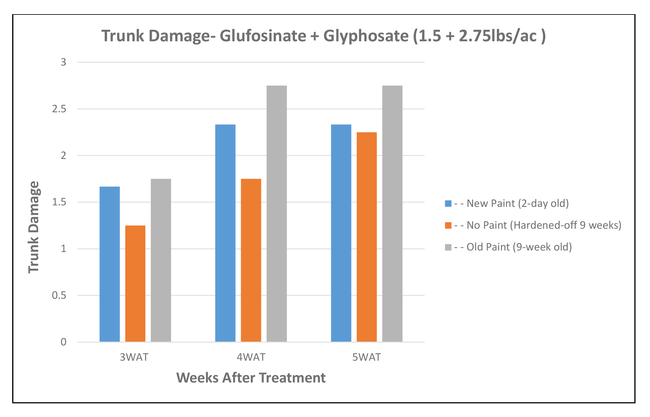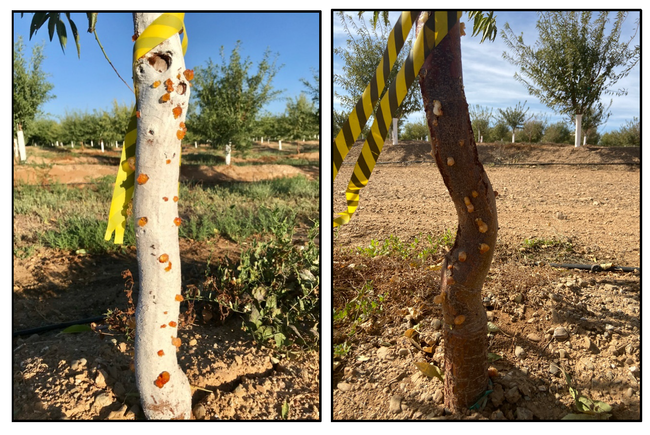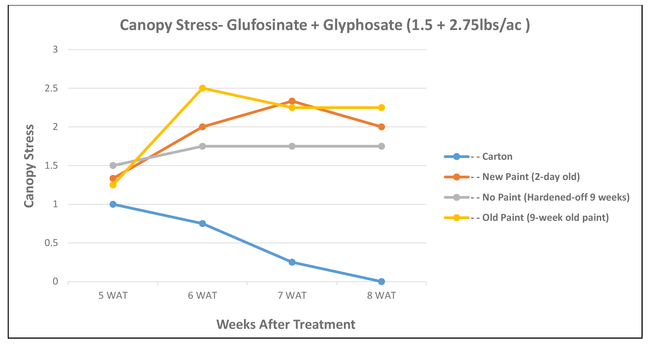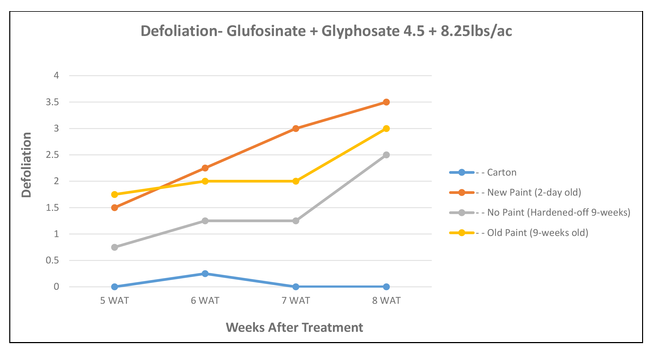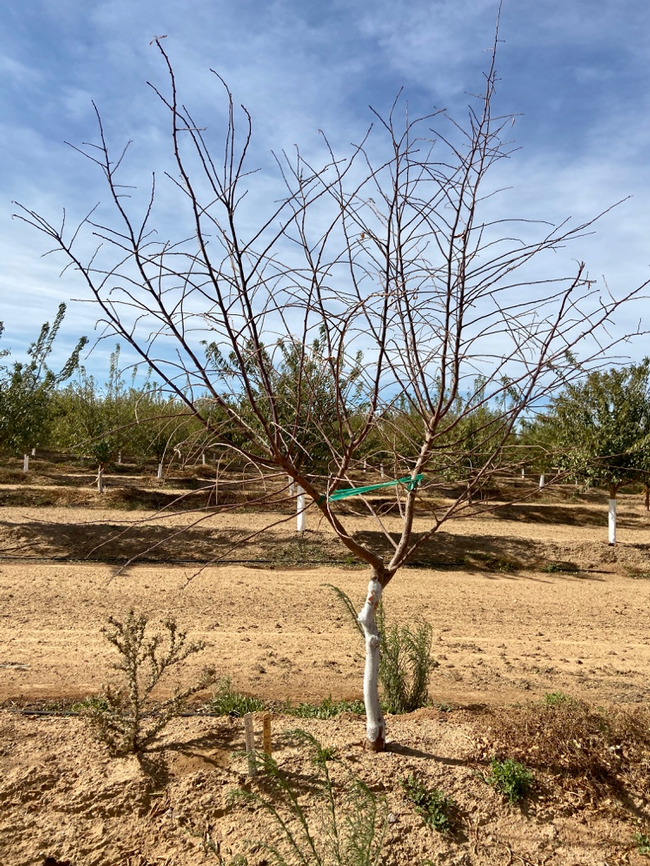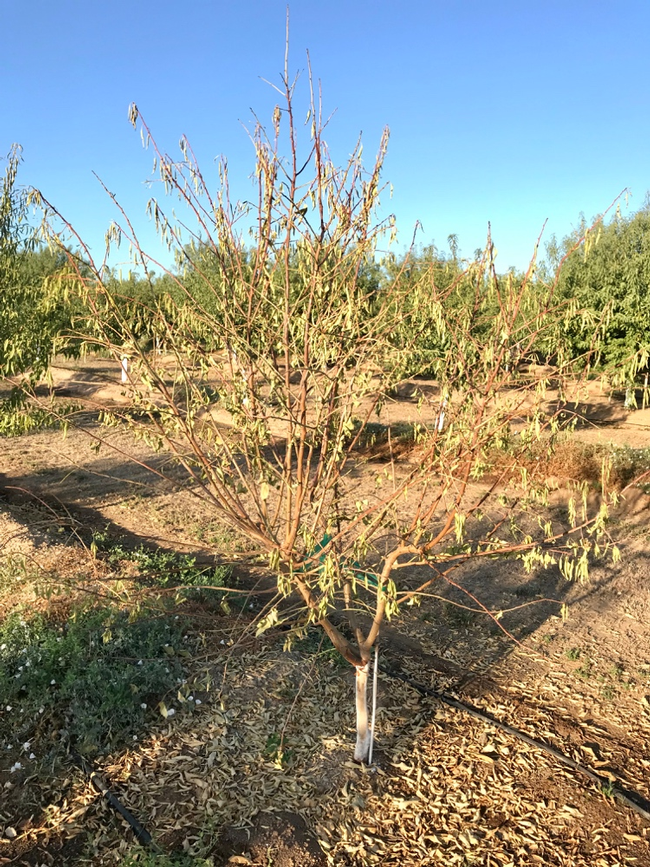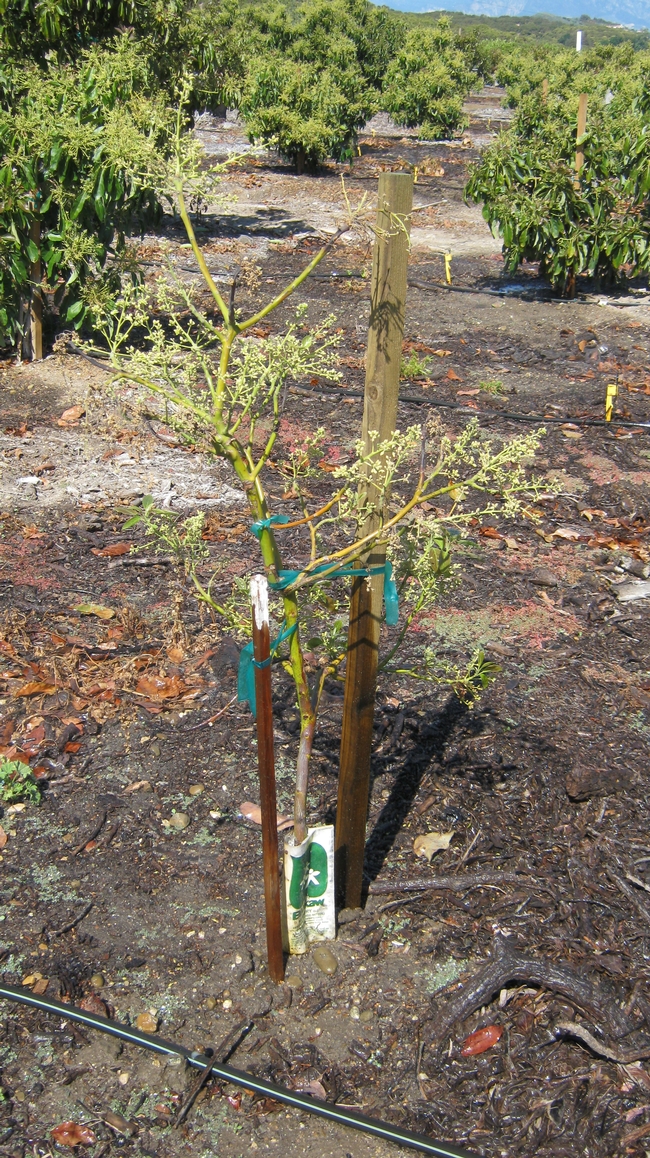- Author: Drew A Wolter
- Author: Dani Lightle
- Posted by: Gale Perez
Introduction
In order to prevent herbicide damage in young trees, especially from postemergence herbicide, standard pomological practice is to apply white latex paint to the bottom 2 to 3 feet of trunk of newly planted trees, before applying herbicides. While this may provide some level of protection, research to support this practice is lacking. In order to assess the efficacy of white latex paint in mitigating herbicide damage, a field experiment was conducted in Arbuckle, CA to evaluate the impacts of latex paint on herbicide injury in young almond trees.
Methods
To conduct this experiment, second-leaf almond trees were grouped into three categories: old paint (9-week old), new paint (2-day old), no paint (hardened-off for 9 weeks), and cartons. On June 20th, 2019 treatment combinations of different rates (see treatment table below) of glyphosate (Roundup PowerMAX), glufosinate (Rely 280), or a tank mix of both were applied. Each treatment combination had 4 replicates.
Herbicide applications
Herbicide applications were made using a CO2 backpack sprayer at 35 psi, and a spray volume of 20 gallons/acre. A single nozzle was held 18 inches from the trunk, moving vertically (from top to bottom) for one second on both the eastern and western side of the trees.
| Herbicide Treatments | |
| Top Label Rate | 3x Label Rate |
| Glufosinate- 1.5lbs/ac | Glufosinate - 4.5lbs/ac |
| Glyphosate- 2.75lbs/ac | Glyphosate - 8.25lbs/ac |
| Glufosinate + glyphosate- 1.5 + 2.75lbs/ac | Glufosinate + glyphosate- 4.5 + 8.25lbs/ac |
Trunk protection
In 2017, the block used to conduct this experiment was planted with greenhouse-grown trees. Each tree came with preinstalled cartons. Nine weeks before the herbicide applications for this experiment took place, the cartons for the “no paint” and “old paint” treatments were removed for the first time, exposing green bark. Valspar interior latex paint diluted 50:50 with water was then applied using a painter's mitt to the group of trees in the old paint treatment. This also allowed for the no paint treatment to harden off for nine weeks prior to the herbicide application. Two days prior to the herbicide application, the cartons for the new paint treatments were removed for the first time (again, exposing green bark) and painted. The cartoned treatments in this experiment never had their cartons removed.
| Trunk Protection |
| Old Paint (9-week old paint) |
| No Paint (hardened-off for 9 weeks) |
| New Paint (2-day old paint) |
| Carton |
Evaluations
Evaluations across three categories of tree stress were taken on a weekly basis, starting three weeks after treatment (WAT) to allow symptoms to develop.
- Trunk damage: Assessments made from 3WAT-5WAT quantified the number of individual gumming sites on each trunk (see Figure 1). No further trunk gummosis was observed starting five weeks after the herbicide applications.
| Rating scale--Trunk Damage | |
| 1 | 0 – 10 Individual sites |
| 2 | 11 – 20 Individual sites |
| 3 | 21+ Individual sites |
- Canopy stress: Evaluations were taken from 5-8WATassessingthedegreeofinterveinalchlorosis,mottledchlorosis, spotting,stackedinternodes, necrosis and stem die back.
Rating scale--Canopy Stress 1 Coming out of stress, exhibiting new growth. 2 Damage, new growth may be present but injured. 3 Leaf drop and further necrosis; no new growth present.
- Defoliation: Ratings were taken from 5-8 WAT assessing the degree of defoliation for each tree (see Figure 2).
| Rating scale--Defoliation | |
| 1 | Less than 25% |
| 2 | 25-50% |
| 3 | Greater than 50% |
| 4 | Complete defoliation |
Results
Preliminary results indicate that paint as a trunk protection method may not provide significant protection from glyphosate or glufosinate. Tree stress caused by trunk-applied herbicides was lowest in most treatments with no paint at all, which suggest that hardening of the bark is key to mitigating herbicide damage in young trees. Examples of treatment combination results shown in images and graphs below.
Trunk damage:
Five weeks after herbicide treatments, data from the top-of-label-rate tank-mix application showed a 22% increase in trunk damage in trees with old paint, and a 4% increase in damage in trees with new paint, when compared to trees with no paint.
Canopy stress:
Eight weeks after treatment, the label rate tank-mix applications showed a 29% increase in canopy stress in trees with old paint, and a 14% increase in damage was observed in trees with new paint, when compared to trees with no paint.
Defoliation:
Eight weeks after treatment, the high rate (3x) tank-mix applications showed a 40% increase in defoliation in trees with new paint, and a 20% increase in defoliation was observed in trees with old paint, when compared to trees without paint that were allowed to harden-off for 9 weeks.
Figure 2. These three images demonstrate the level of defoliation observed 5 weeks after the high rate tank-mix applications were made. Arranged in order of stress response severity: new paint (2a, above) exhibiting the highest level of defoliation, old paint (2b, above), and no paint (2c, below).
Conclusion:
Preliminary results indicate that in most treatment combinations, old and new paint as trunk protection methods did not reduce tree stress caused by trunk-applied herbicides. Allowing the bark of young almond trees to harden off for at least nine weeks reduced herbicide damage. The most efficacious trunk protection option for young almonds trees is to install a carton, though remember when cartons are eventually removed green bark may be present and susceptible to herbicide injury. Therefore, as the trees mature and cartons are removed, allow the bark on trunks of trees to harden off to minimize herbicide damage.
